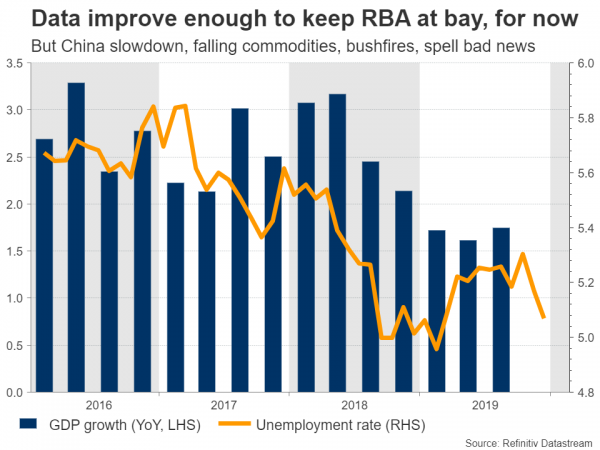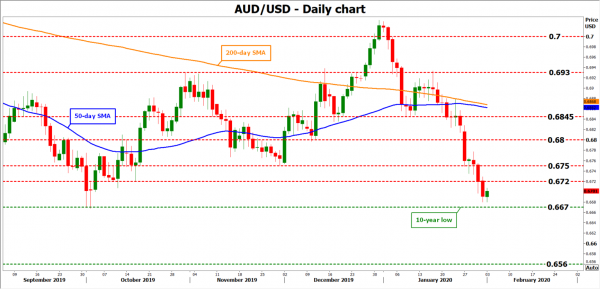The Reserve Bank of Australia (RBA) will announce its rate decision on Tuesday at 03:30 GMT, and markets assign only a 25% chance for a rate cut. While the aussie could spike up if policy is indeed kept unchanged, any positive reaction might remain short lived, as the broader outlook still seems negative amid fears of a severe slowdown in China and falling commodity prices. That said, much will also depend on whether aussie/dollar can break below the 10-year low it is currently testing.
Data pulse improves enough to keep RBA at bay, for now
Australia’s central bank will have a tough balancing act on its hands this week. On the bright side, domestic economic data have improved enough to dispel expectations for an immediate rate cut. In particular, the unemployment rate fell back to 5.1% in December, which is quite significant as the RBA pays a lot of attention to the labor market. Meanwhile, retail sales accelerated in November and inflation picked up in Q4, though it remains below the RBA’s target range.
Given the streak of solid data, the implied probability for an RBA rate cut tomorrow has dropped to a mere 25%, versus ~50% just a couple of weeks ago. Regardless of what happens this week though, markets are saying a near-term cut will remain on the table, fully pricing in such an action by May.
Coronavirus: More than a physical disease for Australia
Much of this pessimism is grounded in the deadly coronavirus, and the potential impact it could have on Australia. For starters, Australia and China have very close trading ties, so if Chinese growth takes a severe hit from virus-related uncertainty, so does Australian growth. Meanwhile, China is the biggest consumer of commodities globally so a slowdown could see commodity prices fall, further hurting Australia, which exports raw materials.
Not to mention the sinister impact this will have on Australia’s tourism industry, which relies heavily on Chinese travelers. On top of everything, there are the raging bushfires to consider, as they threaten to dampen growth further.
And while the nation’s data pulse has improved lately, by no means is it strong. Australian households are among the most indebted in the world, and wages aren’t rising quickly enough to ease that debt burden, which ultimately holds back consumption. Furthermore, underlying inflation remains muted, with little to suggest an imminent pick up.
Aussie might get some relief from RBA, but overall outlook dark
Turning to the market reaction, the fact that some investors are still looking for an immediate rate cut – evident by the 25% probability for one – suggests that the knee-jerk reaction in the aussie might be higher in case the RBA keeps rates unchanged.
Even in that case though, any upside reaction is unlikely to be sustained for long, and the broader outlook for the currency still seems bleak. The Bank will surely maintain an easing bias, global risk sentiment is extremely fragile, and the real impact of the coronavirus on the Chinese – and Australian – economy is still a mystery. For this to change, and for the aussie to be able to stage a sustainable rally, investors may need to see concrete signs that the spread of the disease is slowing down, and we haven’t gotten those yet.
Having said all this, the technical picture is also crucial. Aussie/dollar has already fallen dramatically in recent weeks and is currently trading just above the 10-year low of 0.6670, so one might argue that a lot of the ‘bad news’ are already reflected in the price. Therefore, whether sellers can ultimately break below the 0.6670 zone might be decisive for whether the losses will continue, or not.
If the bears do pierce below 0.6670, the next durable obstacle to provide support might be the 0.6560 region, defined by the highs of February 2009.
On the upside, the bulls may stall initially near 0.6720, where a positive break could open the door for the 0.6750 area.
Finally, note that the nation’s retail sales for December are also due on Thursday.















